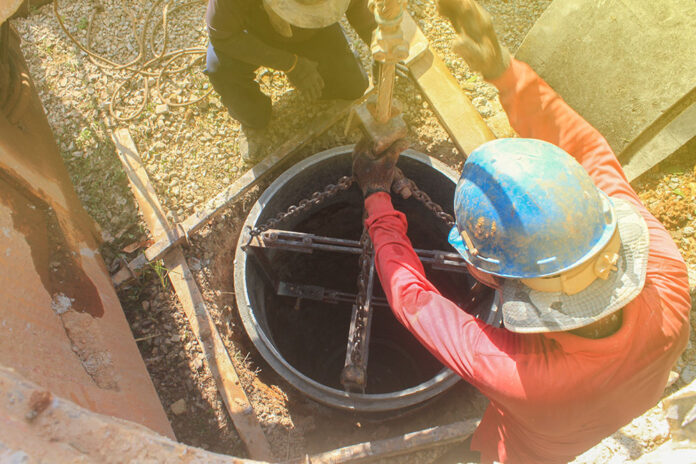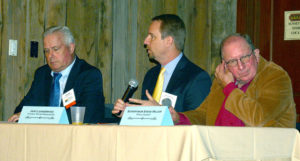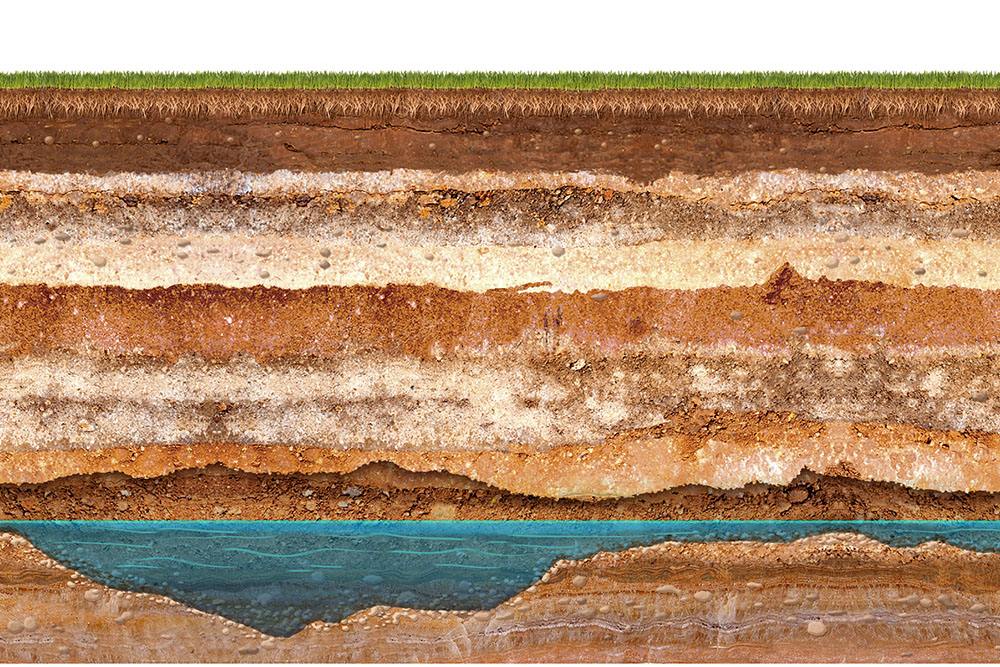
[pull_quote_right]We will deepen wells. We will move wells. That’s our job.[/pull_quote_right]Water is a basic necessity for human existence, and the idea of losing it can cause a visceral reaction.
So, when the director of Arizona Department of Water Resources said Pinal County would be 8 million acre-feet short of meeting demand in 100 years, pushback was almost immediate. Water companies, water groups and elected officials declared the information ADWR included in its update to the Pinal Active Management Area model was flawed.
But while saying ADWR was underestimating water resources and overestimating use, they concurred water conservation is important.
“We definitely need to be using our water as effectively as we can,” said William Garfield, member of Arizona Water Company’s board of directors. “That comes across all water-using sectors. Agriculture has come a long way in improving farming practices. Within our service area in Casa Grande, for example, over the last 20 years, single-family use has dropped 40%.”
That ground-level accounting of current water use sometimes conflicts with the assumptions made at ADWR. The department wanted a comprehensive model that included data from Gila River Indian Community and looked at how communities might impact each other through their water use.
ADWR hydrologists updated and corrected data in the 2014 version of the groundwater model. When they ran the model with the new numbers, the results were alarming. They indicated Pinal County would be 10% shy of meeting demand by 2115.
“Looking out 100 years, there is insufficient groundwater in the Pinal Active Management Area to support all existing uses and issued assured water supply determinations,” ADWR Director Tom Buschatzke said at the time of the release of the information in October and again at a DWR stakeholders meeting in November.
But assumptions behind that declaration have been questioned.
“They assume we are using approximately three times the water we actually are using today,” said Jake Lenderking, director of the Water Resources department at Global Water Resources.
Global Water has a designation of assured water supply of 23,000 acre-feet per year.
“We use about 7,000, so we have lots of room to grow in that proven designation,” he said. The problem is that ADWR’s hydrologists feel impelled to state Global’s current use as 23,000 acre feet.
“From a legal standpoint, because they’ve issued that determination, they feel that they legally have to account for it in the groundwater model because they can’t say whether or not we’re actually using it tomorrow,” Lenderking said. “But I don’t think there’s any practical way we can go from using 7,000 acre feet to 23,000 acre feet next year.”
Lenderking, a board member of the county’s Water Augmentation Authority, has appeared on “Horizon” to discuss such water issues. In November, he, Garfield and Steve Miller, a Pinal County supervisor, tackled the subject as a panel for a Pinal Partnership presentation.

A legislative ad-hoc committee created in 2019 appointed Miller, Garfield and Lenderking to lead a stakeholders process “to hopefully rethink how we do some of this in a scientific way and in a real practical water way,” Lenderking said. “How can we make changes? Can we import water? Can we provide incentives? Is there a good process we can implement that fixes our existing regulator structure, so we can get farm water transferred to municipal water using less?”
Garfield said it should be easier for those with designations or certificates to change to uses that require less water.
How old is your water?
Global Water draws its water supply from the aquifer in the Maricopa/Stanfield Basin and Eloy Basin. It has been gathering there for centuries. The basins are combined in the groundwater model as the major active basins in the Pinal AMA.
“This is what I would call older groundwater. It’s been here a long time,” Lenderking said. “There are sources of recharge along the mountain fronts and the stream beds. The aquifer is replenished through times when the rivers and streams flow. There is also sub-flow moving underground, but it’s very little, and I believe it’s coming up basically in the Santa Cruz drainage, so from the Tucson AMA. It’s very minimal compared to the other things.”
Global Water has nine active wells and a 10th coming online soon. Its water supply is groundwater and effluent or recycled water. It has done its own groundwater flow modeling over time. ADWR counts water as physically available if it is either between the land surface and the bedrock or 1,100 feet, whichever is shallower. It does not consider it available below 1,100 feet.
“The aquifer over here goes about 8,000 or 9,000 feet below land surface,” Lenderking said. “We’re only allowed to count to 1,100 feet in the assured water supply program.”

He said the ADWR model counts only existing wells and their existing depth, which he said is also misleading.
“We will deepen wells. We will move wells. That’s our job,” he said. “I think we’re going to see water supplies imported into the Pinal AMA over time that are going to also help to change this picture. I don’t see any real municipal demand, the way it stands today and the way it’s growing today, being unmet.”
The assumptions about wells in the Pinal AMA skewed the modeling results, he said.
Even in simulated animation of the 100-year flow modeling by ADWR, the Maricopa area looks to be sitting on a surplus of water while the rest of the Pinal AMA dries out. Global Water has long stated Maricopa is in “a very nice place” in its access to water.
Assured Water Supply
ADWR’s groundwater flow model considers all grandfathered rights like agriculture, designated and certificated rights such as municipalities and utilities and then analyses of assured water supply, which are anticipated requests that would need to be converted into certificates. Though they account for 11 million acre feet in the model, ADWR is doubtful any of the analyses would get approval.
Permitted water use is five times what actually is being used today. Those trying to get in line for certificates have a hard row to hoe.
“DWR has made abundantly clear that the water people have asked for, they need subsequent approvals and are very unlikely to get them,” Lenderking said. “When you think about the fact that they’re not going to allow any of those analyses to go forward, is there really a shortfall? Did they really overissue? Are we really in a long-term deficit? No.”
That virtual hold on certificates of assured water are causing frustration. The ad-hoc committee – comprised of lawmakers David L. Cook, Noel Campbell, Rosanna Gabaldón, Gail Griffin, Bret Roberts and Diego Rodriguez, with Buschatzke as a member as well – was created to find solutions to the “groundwater physical availability issue.”
“Having been a builder, a developer, and having gone through the process of getting a certificate of assured water… having close ties to the agricultural community, I’ve seen the issues,” Miller said. “I’ve seen them coming for a long time.”
Garfield said the stakeholder process may be the best option for finding a path for developers to gain a certificate. Some might come to the table with their own water supply, such as an agreement with a Native American community for Central Arizona Project water, but those would be special circumstances.
Miller quoted iconic cattleman and member of the Governor’s Water Augmentation Council Bas Aja’s idiom, “If money can fix the problem, you don’t have a problem.”
This story appears in the January issue of InMaricopa.

![3 things to know about the new city budget Vice Mayor Amber Liermann and Councilmember Eric Goettl review parts of the city's 2024 operational budget with Mayor Nancy Smith on April 24, 2024. [Monica D. Spencer]](https://www.inmaricopa.com/wp-content/uploads/2024/04/spencer-042424-preliminary-budget-meeting-web-218x150.jpg)






![MHS G.O.A.T. a ‘rookie sleeper’ in NFL draft Arizona Wildcats wide receiver Jacob Cowing speaks to the press after a practice Aug. 11, 2023. [Bryan Mordt]](https://www.inmaricopa.com/wp-content/uploads/2024/04/cowing-overlay-3-218x150.png)



![Alleged car thief released without charges Phoenix police stop a stolen vehicle on April 20, 2024. [Facebook]](https://www.inmaricopa.com/wp-content/uploads/2024/04/IMG_5040-218x150.jpg)

![3 things to know about the new city budget Vice Mayor Amber Liermann and Councilmember Eric Goettl review parts of the city's 2024 operational budget with Mayor Nancy Smith on April 24, 2024. [Monica D. Spencer]](https://www.inmaricopa.com/wp-content/uploads/2024/04/spencer-042424-preliminary-budget-meeting-web-100x70.jpg)


